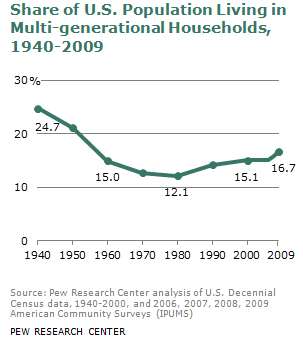 The Pew Research Center recently released “Fighting Poverty in a Tougher Economy, Americans Move in with Their Relatives.” The report considers how the Great Recession has influenced household composition. Over the last few years, more and more people have opted to live in multi-generational households as a means of handling economic pressures.
The Pew Research Center recently released “Fighting Poverty in a Tougher Economy, Americans Move in with Their Relatives.” The report considers how the Great Recession has influenced household composition. Over the last few years, more and more people have opted to live in multi-generational households as a means of handling economic pressures.
A longer term look at household composition shows that the percentage of those living in multi-generational households declined from 1940 until 1980, then started rising and has continued to rise ever since. While the current level (16.7%) represents a significant increase during the early years of the Great Recession and is the highest rate in half a century, it is still roughly 50% below the 1940 rate.
So What?
The significant acceleration in the rate of increase of multi-generational households as a percentage of all households during the early years of the economic downturn illustrates the role the economy is playing on household composition:
From 2007 to 2009, the number of Americans living in multi-generational households grew by nearly 5 million, a 10.5% increase at a time when the overall population grew only 1.8%. About half of the increase since 2000 in the number of Americans living in multi-generational households took place from 2007 to 2009. The rate of growth was also twice the rate that had prevailed from 1980 to 2006.
While the trend is impacting people of all ages, young adults (ages 25 to 34) have experienced the greatest change. From 2007 to 2009, some 1.3 million young adults shifted from living in a single generation household to a multi-generational household, which is a 16.8% increase.
- How has your church responded to this trend? How have your congregation’s ministries to young adults and/or those who were previously empty-nesters but are no longer so changed over the last three to five years?
- Do you expect the trend toward more multi-generational households to continue at its current rate, to slow, or to accelerate over the next five years? What implications might each have for your congregation, and how can your leadership body(ies) proactively consider what this may mean for various ministry groups and activities?